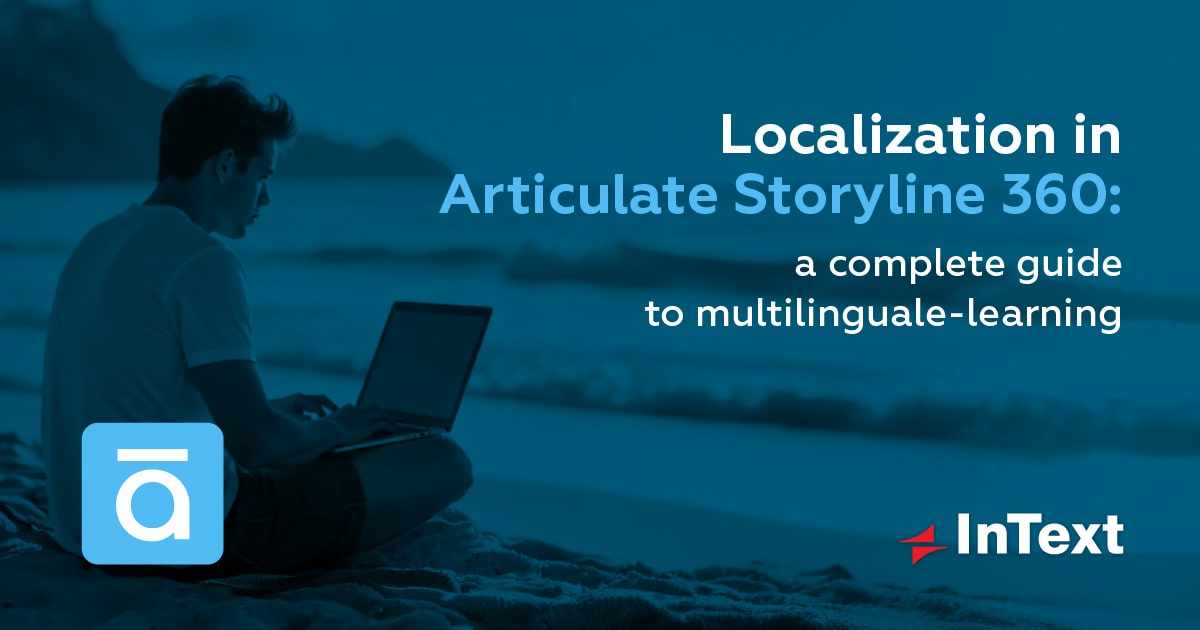
This article was originally published on LearningGuild.com


Digital corporate education is evolving, and many global businesses are localizing e-learning content to bolster the knowledge and skill sets of their geographically diverse multilingual teams. Localization is a significant part of this, as it ensures accessibility and clarity. It also fosters engagement among employees, irrespective of their location and linguistic background.
Articulate Storyline 360 stands out as a leading platform for authoring interactive training content, offering extensive features for multilingual learning. However, adapting content for multiple markets using Storyline presents a distinct set of technical, linguistic, and process-related challenges, many of which are unfamiliar to those used to localizing static documentation or web content.
This article draws on firsthand experience to outline the key stages of content preparation, translation, and post-processing within the Articulate Storyline 360 environment. Instead of looking at program features, we focus on practical aspects of localization, including typical tasks, common errors, and best practices for maintaining high quality and linguistic consistency across locales. While intended for localization professionals, the insights are equally valuable for global training managers planning to scale their internal learning programs across languages and regions.
During Storyline initialization, missing fonts are displayed in a separate dialog box:

 Missing Fonts dialog box
Missing Fonts dialog box
You should check if these fonts support the target languages. Storyline does not warn about missing characters in target languages; it automatically uses system fonts instead.

 Garbled display of target language characters due to font issues
Garbled display of target language characters due to font issues
This can cause subtle inconsistencies: while most of the text will appear visually correct, certain characters will be rendered in a different font.

 Language-specific characters rendered in a different system font
Language-specific characters rendered in a different system font
Detecting this can be tricky, so it’s best to check fonts on a larger text sample using a tool like Adobe InDesign. Paste a paragraph with characters specific to the target language, apply the original font, and any missing characters will be highlighted in red.
Textual elements within images may be non-editable but require localization. To view a complete list of images, navigate to the Media Library under the View tab.

 The Media Library panel
The Media Library panel
The Media Library also shows slide assignments for images:
 Button to jump to the location of an image file
Button to jump to the location of an image file
To streamline text inspection, you can export images as separate files.
 Image export button
Image export button
The next step is to identify and select elements that need to be prepared for translation.
Because images can be incorporated into animations or associated with object groups, we recommend preparing textual elements within images by exporting them to an external file (such as a bilingual DOCX table) rather than processing them directly in Storyline. Integrating text frames directly into the project file will substantially increase the complexity of the setup needed to maintain animations and related elements.
In addition, one image can be referenced across different slides. To be efficient, we should prepare it once and then replace it once after translation.
As with images, the Media Library provides functionality to view and export audio and video files used in the project:

 Audio and Video tabs in the Media Library
Audio and Video tabs in the Media Library
At this stage, identify the video and audio files to be prepared for translation. This process can include exporting on-screen text, preparing subtitles, and replacing voice-overs. Preparation of video and audio for translation is a separate process with numerous intricacies.
Some slides may incorporate layers and slide masters (templates that define layout and design across multiple slides):
 Layer organization dialog box
Layer organization dialog box

 Slide master organization dialog box
Slide master organization dialog box
Both layers and slide masters should be taken into account when estimating the workload, as there can be quite a few of them, and processing them will take time.
Individual slide elements can have multiple states:

 An element in various states
An element in various states
States are typically used for button elements and similar interactive controls. The text within different states can vary, and this needs to be considered when analyzing the workload.
There are two export formats available for translation: XLIFF and DOCX. The choice is up to the client.

 The export panel
The export panel
When exporting to DOCX, the number of slides, layers, templates, and other assets important for a general understanding of the scope of work is indicated in the report at the beginning of the file.
The translation stage begins after completing analysis and exporting. Beyond technical accuracy, translations need to be contextually coherent, particularly given that the same element may have multiple uses throughout the course.
Key considerations during translation include:
Bear in mind that insufficient context (such as the absence of screenshots) can compromise the quality of the translation output. Hence, we suggest giving linguists a DOCX report or credentials to access a preview environment.
During Storyline initialization, missing fonts are displayed in a separate dialog box:

 Translation import dialog box
Translation import dialog box
It is common for errors to arise during importing. A prevalent cause of import errors is the lack of successful alignment between source and target texts. Storyline does not report the cause of an error. Pay special attention to the target language during formatting.
Storyline is not equipped with automatic text scaling functionality. Therefore, if translated phrases become longer (which often happens), you should:
If styles were used in the project, they can be reapplied; however, their infrequent application during course development adds complexity to the process.
Use the Replace Fonts tab, located within the Home —> Paragraph —> Find/Replace menu, to perform a global font replacement across the entire file.
 Replace Fonts dialog box
Replace Fonts dialog box
To replace localized images, video, and audio, use the Replace option in the Media Library.
 Multimedia replacement dialog box
Multimedia replacement dialog box
The system automatically updates a replaced file across all slides where it is used.
Subtitles can be added to audio and video elements. All standard formats are supported: SRT, VTT, SBV, and SUB.
Storyline features AI-powered voice generation. Using Insert Text-to-Speech functionality, a voice can be synthesized from text through AI Audio.

 Audio generation dialog box
Audio generation dialog box
Storyline supports a range of publishing formats.

 Publish dialog box
Publish dialog box
Critical steps before the final version is generated:
Effective localization of e-learning content using Articulate Storyline 360 requires an end-to-end approach, from meticulous content preparation through post-processing and on to generation of the final version. The way interface elements, slide arrangements, multimedia integration, interactivity, and hidden content are implemented sets this localization process apart from those of other software.
Gaining a deep understanding of Storyline helps project teams avoid hidden pitfalls, streamline the workflow, and reduce costs caused by revisions and backtracking. More importantly, it enables a consistent user experience across languages, which is critical for global learning effectiveness.
In our experience, success in Storyline localization is rarely about translation alone. It comes from working with teams who specialize in e-learning workflows — teams who understand both the tool and the learning context, and who can collaborate early with content owners to flag risks before they become blockers.
Organizations that treat e-learning localization as a strategic function, not a final step, gain the ability to launch multilingual courses faster, with greater confidence in quality and learner engagement. Ultimately, the result is learning content that performs consistently, resonates culturally, and helps global teams thrive.